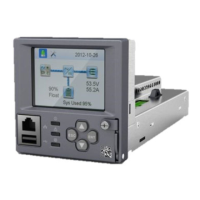Vertiv™ NetSure™ Control Unit (NCU) User Manual
Hybrid Operation
Generator Control: A potential free relay contact output from the NCU interface board controls the start and stop of the diesel
generator. The signal will be generated by the NCU and operates according to the Hybrid software mode of operation. The default
control logic (User selectable) is as follows:
• Energized Output Relay - Generator OFF
• De-energized Output Relay – Generator ON
This is a fail-safe logic to ensure generator operation in all cases where power or control to the relays is lost.
In addition, the type of signal to the Generator can be selected as N/O (Normally Open) or N/C (Normally Closed) by selecting the
relevant output pins of the control relay.
Number of Generator Control Outputs: The NCU Hybrid software can control one or two generators. Each generator control is
designated as DG1 or DG2 output. The User can select DG1, or DG2, or DG1 and DG2. When both are selected they will be
alternatively used (two generators operation).
Diesel Fail Alarm: A diesel fail alarm will be generated if the Diesel Generator ON signal fails to bring the generator to operation and
provide the system with AC power. Alarm will be triggered after 60 seconds (default value, settable) from ON signal. If two generator
operation is selected, the second Diesel Generator ON signal will be activated simultaneously with the Diesel Fail alarm.
Battery Fuse Trip Alarm: In the event of a Battery Fuse trip condition, an alarm will be generated.
Under Voltage Alarms:
• Under Voltage Alarm 1: If voltage decreases below the Under Voltage Alarm 1 setting, an alarm is raised.
• Under Voltage Alarm 2: If voltage decreases below the Under Voltage Alarm 2 setting, the Diesel Generator is started and
an alarm is raised.
LVD 1: Normal loads are disconnected.
LVD 2: Priority loads are disconnected.
Charge Voltage: Refer to Figure 1.6.
Equalize Charge: The battery will be recharged at the equalize voltage. This is the voltage set in the initial phase of battery
recharge. See Figure 1.6.
As the voltage limit is reached, the charge current is gradually reduced – this effect is known as current tail. When the current tail falls
below a threshold level, additional equalize charge time is added and then the recharge ends.
The equalize charge current tail threshold is settable from 0.002 to 0.02. Default setting is 0.01 (1 A per 100 Ah). The additional
equalize charge time is settable from 1 hour to 24 hours (settable in minutes from 0 to 1440), default setting is 3 hours. The duration
of the equalize charge is the time from the start of the recharge to the end of the additional time. (Maximum charge time, determined
from the time charge starts, is settable in the range of 1 hour to 48 hours, default setting is 18 hours).
The end of recharge is determined by a three (3) step approach:
• Step1 - calculated battery capacity exceeds 90%. Calculation is performed by measurement of battery current and time, in
Ah.
• Step 2 - charge current tail threshold is reached.
• Step 3 - additional charge time is completed.

